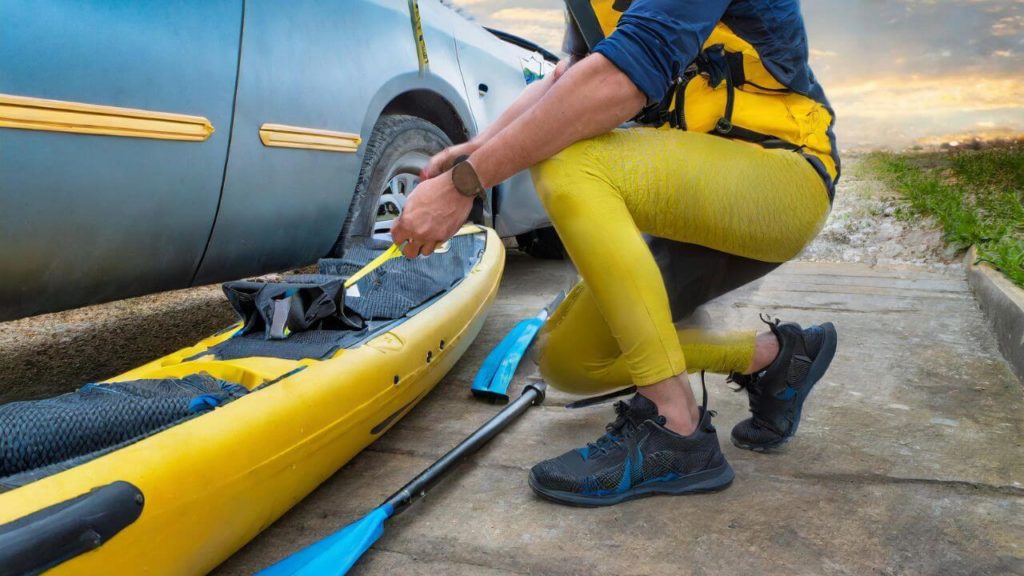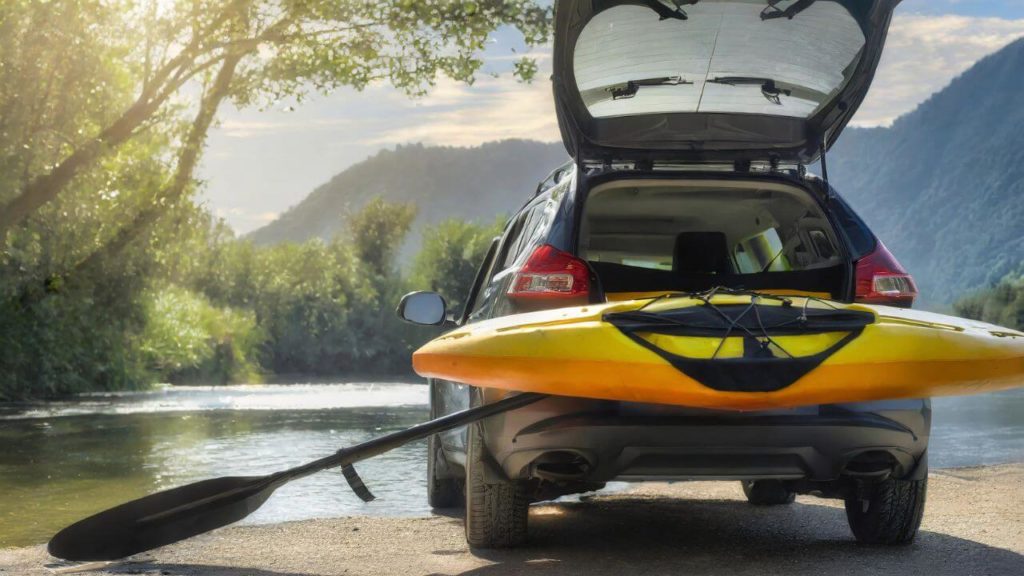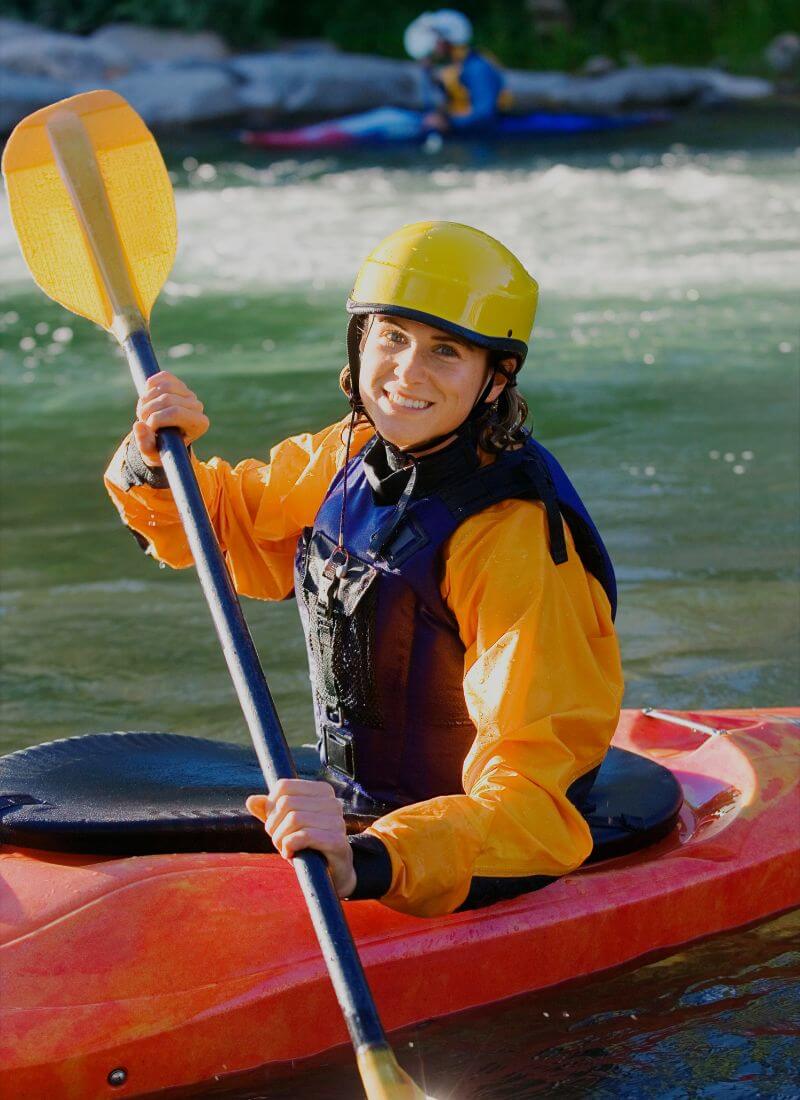You’re all set for a day of kayaking, but there’s one small problem: you don’t have a roof rack, the most common way to transport a kayak. So, transporting your kayak can be a challenge, especially if your car doesn’t have a roof rack. In this blog post, I will discuss how to carry a kayak without a roof rack, the benefits of doing so, and the necessary precautions to take. So let’s learn in detail.

Note: The methods covered here work best for smaller kayaks under 13 feet long and weighing less than 40-50 lbs. Larger sea kayaks over 15 feet long may prove more difficult to carry without roof racks. However, with careful technique, even big kayaks can potentially be transported using some of these roof rack-free approaches.
5 Steps Guide To Carry A Kayak Without A Roof Rack
Follow the steps to carry a Kayak without a roof rack:
Step 1: Get Prepared
Before loading your kayak onto your vehicle, you’ll want to take some preparatory steps to make the process easier and prevent any damage.
The most important thing is to assess the size and weight of your kayak. Measure the length, width, and height and note the weight. This will allow you to determine the best loading options for your vehicle. It’s also a good idea to measure the interior dimensions of your vehicle.

You’ll want to pad any contact points between the kayak and vehicle. Foam blocks, pool noodles, towels, blankets, or other soft padding can protect the hull from scratches. You can place padding on the roof, hood, interior floor, and rear hatch area.
Taking a few minutes to prepare will make loading your kayak much easier and prevent vehicle damage. Know the dimensions, pad contact points, and wear suitable footwear before getting started.
Step 2: Choose The Right Placing Option
Choosing the right placing option for your kayak is a critical step. It’s crucial to consider the size of your vehicle and the kayak. You can try following options to place your kayak safely:
Car Top Options
No roof racks? No problem! You can still carry your kayak on top of your car without them. Foam blocks or inflatable pads can serve as a viable solution. They can be strapped down to your car using strong ropes or straps, providing a secure and steady platform for your kayak. This method is cost-effective, easy to install, and can be used on almost any vehicle. However, remember to strap the kayak securely to avoid any slippage during transportation.
Interior Options
Another option to consider is carrying your kayak inside your car. This method is most suitable for smaller kayaks or inflatable ones. The first step is to fold down the rear seats to create enough space for the kayak. Then, slide the kayak into the car, ensuring it fits securely. This method not only protects your kayak from potential damage but also eliminates the worry of it falling off during transportation.
Rear Options
Rear options are another practical way on how to carry a kayak without roof racks. Hitch-mounted carriers or tailgate pads can be a great solution. You can attach these carriers onto the back of your car that can hold one or more kayaks securely. They can be installed and removed easily making them a suitable option for kayak transportation. Ensure to strap down your kayak properly to prevent any movement while driving.
Roof Options
Yes, it’s possible to carry a kayak on your car roof without roof racks! Using pool noodles or foam blocks can be a simple and affordable solution. Simply, attach them to the roof of your vehicle and secure them with appropriate straps or ropes. Then, place your kayak on top and secure it with additional straps. This method requires careful installation to ensure the kayak is secure and won’t damage your car roof.
Step 3: Loading the Kayak
Loading the kayak onto your car might require an extra pair of hands. It’s best to lift the kayak from both ends and place it gently onto the foam blocks or pool noodles. Once you’ve got the kayak all set on the roof, use the tie-down straps to make sure it’s not going anywhere! Make sure it’s tight enough to keep the kayak in place but not so tight that it damages it.
Next, secure the bow and stern of the kayak to the front and rear of your car using additional straps or ropes. This way, your kayak won’t move around or fall off while you’re driving. Make sure all the belts and knots are tight before you take off.

Step 4: Driving Safely
With the kayak securely strapped to your car, you’re almost ready to go. However, remember that driving with a kayak on your roof will affect your vehicle’s handling. Be conscious of your speed, especially when taking corners or driving in windy conditions. It’s also a good idea to periodically check the straps during your trip to ensure the kayak remains secure. Furthermore, be mindful of any low-hanging branches or structures overhead that could potentially damage the kayak. Take extra care when entering parking garages or driving under bridges.
When driving with a kayak on your roof, be sure to increase your following distance behind other vehicles to allow for any sudden stops or maneuvers. The added weight and wind resistance of the kayak may impact your braking distance.
Also, be aware of the height of your vehicle with the kayak on top, especially when entering parking garages or drive-thru locations. Don’t forget to watch out for the extra height when you’re driving in tight spaces or areas with limited clearance.
Step 5: Unloading
Once you’ve reached your destination, unloading is pretty much the reverse of loading. Take the straps off and gently lift the kayak from the car’s top. Remember, it’s always safer to have a helping hand. Once the kayak is off the roof, place it on the ground or in a safe area. Make sure to secure it to prevent it from rolling away or getting damaged. Don’t forget to take off any gear or stuff from your kayak before you put it away. If you used any padding or cushions while transporting the kayak, make sure to remove them as well.
After unloading the kayak and securing it properly, don’t forget to re-tighten any straps or tie-downs that you may have loosened during the unloading process. Once everything is secure, double-check that all of your gear is accounted for and that nothing was left behind. Finally, take a moment to reflect on your successful kayak trip and start planning your next adventure.
Benefits Of Carrying A Kayak Without A Roof Rack
The main benefits of carrying a kayak without a roof rack include:
- Avoiding the cost of buying and installing roof racks. Roof rack systems can be expensive, ranging from $150 up to $700 or more.
- Greater convenience. Hauling your kayak is much easier without having to mount and dismount roof racks each time.
- Adaptability. You can carry a wider variety of kayak types and sizes without relying on specific roof rack configurations.
- Lower overall vehicle height. Eliminating roof racks results in a lower load height that’s easier to manage.
Conclusion
When transporting a kayak without a roof rack, careful preparation and caution are key. There are several techniques as I discussed above that allow you to safely and securely carry a kayak, but each has its challenges.
Whichever method you choose, prep the vehicle and arrange tie-downs before loading the kayak. Check all straps and padding for security. Drive cautiously and avoid sudden braking or sharp turns. Have a plan for safe unloading once you reach your destination. Take your time and recruit a helper when needed. With good preparation and care, you can take your kayak anywhere without a roof rack.
FAQs
What Alternatives Are There To Carrying A Kayak Without A Roof Rack?
If you don’t have a roof rack, you can also transport your kayak using a kayak trailer, in the bed of a pickup truck, or by using a trailer hitch. Kayak trailers are made just for hauling kayaks and can be easily hooked up to the back of your car. They typically have a padded surface to protect your kayak during transport and are equipped with straps to secure the kayak in place.
Can I Transport More Than One Kayak Without A Roof Rack?
Yes, you can! If you don’t have a roof rack and need to transport two kayaks, just put them side by side on foam blocks or pool noodles and tie them down with straps.
Also Read:

